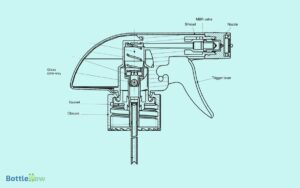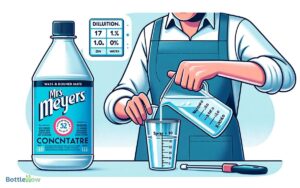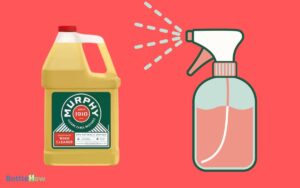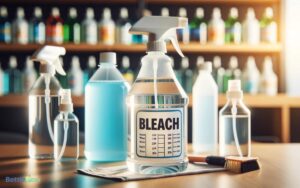Mist Vs Spray Bottle: Which One Better!
Mist bottles create a fine, cloud-like dispersion that evenly covers a broad area, ideal for delicate plants or skincare routines.
In contrast, spray bottles rely on a trigger mechanism that delivers a more forceful stream, perfectly suited for targeted cleaning or gardening tasks.
The efficiency of both types lies in their design elements—such as reservoirs and nozzles—ensuring proper atomization and minimal waste. Maintenance is crucial, involving regular checks and cleanings to ensure longevity.
Depending on your use, one may suit better than the other in terms of application precision and liquid conservation. Discovering more about each type can further streamline your decision-making process.
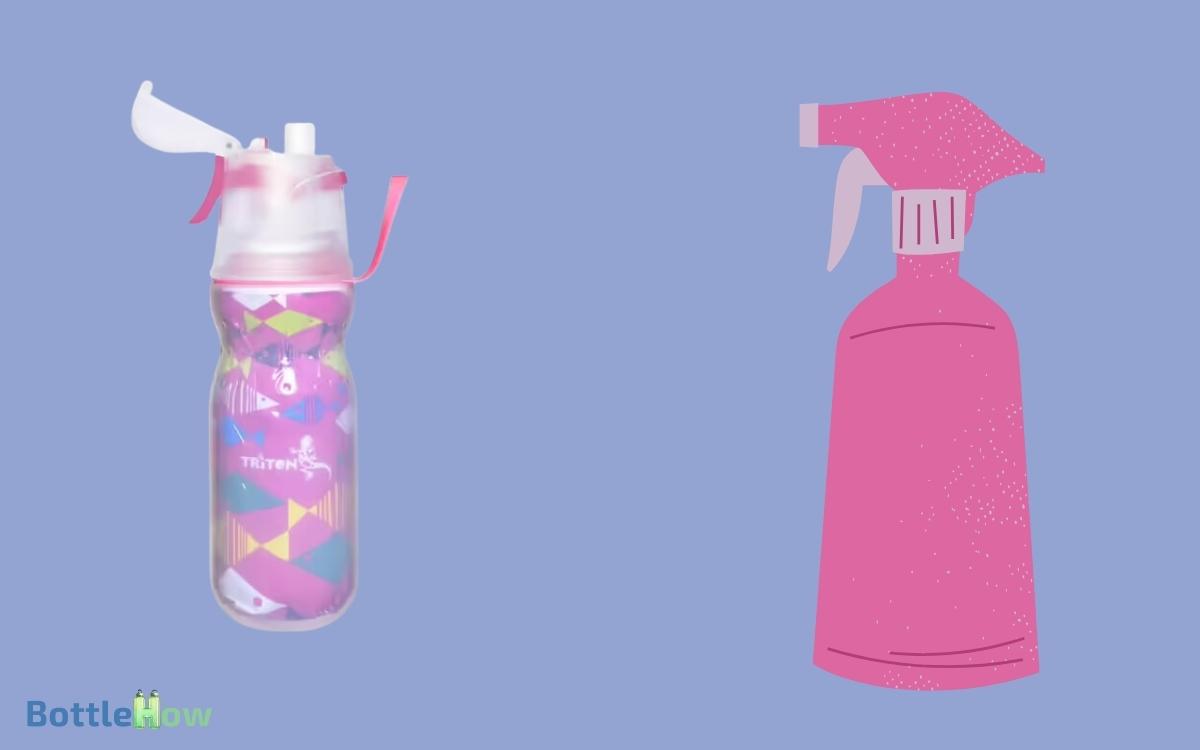
Comparison table between mist and spray bottles
| Feature | Mist Bottle | Spray Bottle |
|---|---|---|
| Dispersion | Produces a fine mist of liquid particles | Produces a broader spray of liquid |
| Particle Size | Smaller particles, more uniform coverage | Larger droplets, may provide heavier coverage |
| Intended Use | Often used for skincare, plants, hair | Used for various applications such as cleaning, gardening, hair styling |
| Coverage Area | Covers a smaller area more evenly | Covers a larger area with each spray |
| Evaporation Rate | Liquid evaporates faster due to smaller particles | Liquid may take longer to evaporate due to larger droplets |
| Control | Offers more control over amount dispensed | May require more careful handling for precise application |
| Portability | Typically smaller and more portable | Can vary in size, from compact to larger options |
| Versatility | Can be used for delicate applications | Suitable for both delicate and heavy-duty tasks |
| Examples | Facial mists, plant spritzers | Household cleaners, hair setting sprays |
Key Takeaways
Understanding Mist Bottles
Mist bottles, designed to deliver a fine spray, distribute liquid more evenly than traditional spray mechanisms.
You’ll find these tools indispensable in environments where precision and gentle application are paramount.
Unlike heavier sprays, mist bottles produce a cloud-like output that settles softly on surfaces, minimizing waste and ensuring thorough coverage.
This attribute is particularly beneficial when you’re working with sensitive plants, delicate skincare products, or cleaning surfaces that shouldn’t be saturated.
Moreover, the mechanics of mist bottles allow for a controlled release of fluids, offering you the ability to moderate how much liquid is dispersed with each actuation.
This level of control helps to maintain the integrity of the product being used, supporting sustainable practices and efficient resource use.
How Spray Bottles Work
You’ll find that the mechanics of a spray bottle hinge on the efficient design of its trigger mechanism, which, when activated, precisely controls the expulsion of liquid.
This operation hinges on the conversion of a liquid into a fine spray, a process known as atomization, which is critical for the bottle’s functionality.
Understanding how these elements interact provides insight into why spray bottles are effective for a wide range of applications, from cleaning to gardening.
Spray Bottle Mechanics
A spray bottle’s mechanism relies on a simple yet effective pump-action system that allows you to dispense liquids in a fine mist.
As you press the trigger, it activates a small pump that draws liquid up through a tube from the reservoir at the bottom of the bottle.
This liquid is then forced through a narrow nozzle, which breaks the liquid into small droplets that form the mist you see.
| Component | Function | Importance |
|---|---|---|
| Reservoir | Holds the liquid | Essential for storage |
| Pump | Moves liquid to the nozzle | Critical for operation |
| Nozzle | Atomizes liquid into a mist | Key for proper spray |
Understanding these components helps you maintain and effectively use your spray bottle, ensuring peak performance and longevity.
Trigger Operation Explained
Let’s now examine how the trigger mechanism in a spray bottle functions when you press it, initiating the spray process.
As you squeeze the trigger, it activates a small pump located inside the handle. This pump is connected to a plastic tube that extends to the bottom of the bottle, drawing liquid up through the tube as the trigger is engaged.
With each squeeze, the pump forces the liquid up and through a narrow nozzle at the top of the spray bottle.
This mechanism relies on simple physics but requires precise engineering to guarantee consistency and efficiency in liquid delivery.
Each component must be meticulously designed to avoid leaks and ensure that the spray function performs reliably every time you need it.
Liquid Atomization Process
Understanding how spray bottles atomize liquid into a fine mist involves delving into the mechanics of the nozzle and pressure system.
When you press the trigger, you’re actually increasing pressure within a sealed container. This action forces the liquid up through a tube toward a key nozzle.
The nozzle design is vital; its tiny opening restricts liquid flow while simultaneously breaking the stream into smaller droplets.
This process, known as atomization, transforms the liquid into a mist, making it easier to distribute evenly over a wide area.
This functionality is particularly valuable in applications requiring careful, measured distribution of liquids, such as in cleaning or gardening.
The precise control helps guarantee efficient use of resources, aligning with a mindset of service and conservation.
Key Differences Explained
You’ll find that mist and spray bottles differ considerably in their application techniques and the volume and coverage they provide.
Mist bottles typically emit a finer, more diffuse spray which covers a larger area with less liquid, ideal for gentle hydration or even distribution.
Conversely, spray bottles often release a more concentrated, forceful spray, making them better suited for targeted applications where more liquid is needed quickly and precisely.
Application Techniques Compared
When contrasting the application techniques of mist versus spray bottles, it’s essential to contemplate how each method distributes liquid over a targeted area.
Let’s analyze the key differences using an illustrative approach:
- Coverage Precision: Spray bottles offer a more focused and direct application, ideal for targeting specific spots without overspread.
- Particle Size: Mist bottles produce finer droplets that disperse more uniformly, covering a broader area gently and evenly.
- User Control: With spray bottles, you can control the intensity and range of the spray by adjusting the nozzle or the pressure you apply.
- Saturation Level: Mist tends to lightly coat surfaces, whereas spray can deliver a heavier, more saturating application depending on the settings and usage.
Understanding these aspects helps ensure you’re utilizing each bottle type effectively to serve specific needs efficiently.
Volume and Coverage Analysis
Let’s explore the key differences in volume and coverage between mist and spray bottles, focusing on how each type affects the application’s efficiency and effectiveness.
Mist bottles emit a finer, more diffuse spray, which provides a gentle, even coverage over a larger area with minimal product usage.
This makes them ideal for applications where a light, even coating is beneficial, such as in hairdressing or skincare.
On the other hand, spray bottles typically release a more concentrated, forceful spray, delivering a greater volume of liquid in a more localized area. This is preferable for tasks requiring targeted application, like cleaning tough stains.
You’ll find that choosing between a mist or spray bottle depends significantly on your need for precision or broad coverage.
Optimal Uses for Mist Bottles
In many settings, mist bottles prove essential for delivering a fine spray of liquid evenly and gently.
You’ll find their precision and soft application particularly advantageous in environments where meticulous care is paramount.
Here are some ideal uses:
- Hairdressing: Perfect for moistening hair during cutting or styling, ensuring even dampness without over-saturation.
- Gardening: Excellent for watering delicate seedlings and plants, providing hydration without the force of a traditional watering can.
- Skincare: Useful in applying toners or invigorating mists that require a gentle touch to avoid disrupting the skin’s natural balance.
- House Cleaning: Effective for distributing cleaning solutions thinly over surfaces like glass or mirrors without leaving streaks or excess moisture.
Each application underscores the mist bottle’s role in precise, controlled dispensation of liquids.
Best Practices for Spray Bottles
When selecting a spray bottle, you should always consider the type of nozzle, as it determines the spray pattern and intensity suitable for your application.
Filling your spray bottle correctly not only guarantees efficiency but also prolongs the lifespan of the mechanism.
Regular maintenance and proper care are essential to prevent clogging and degradation of the bottle’s components.
Choosing the Right Nozzle
Selecting the appropriate nozzle is crucial for optimizing the functionality and efficiency of your spray bottle.
The right nozzle guarantees that you can deliver solutions effectively, catering precisely to the needs of those you serve.
Here are key factors to take into account:
- Spray Pattern: Determine whether a fine mist or a direct stream is necessary for your tasks. Finer mists are ideal for even distribution over large areas, while streams target specific spots.
- Material Compatibility: Make sure the nozzle material is resistant to the chemicals in your spray, preventing degradation and ensuring longevity.
- Adjustability: Look for nozzles that offer variability in spray output to suit different applications.
- Durability: Choose nozzles known for their robustness, especially if frequent use is anticipated in your service.
Proper Filling Techniques
To guarantee peak performance and longevity of your spray bottle, it’s imperative to master proper filling techniques.
Always start by making sure your bottle is clean and free from any residues. This prevents clogging and maintains the quality of the spray.
When filling, use a funnel to avoid spills and ensure the liquid is poured smoothly into the bottle. It’s vital to leave some air space at the top; this space is necessary for the pressure to build up and deliver a consistent spray. Always check for the maximum fill line and don’t exceed it.
Using distilled or purified water can prevent mineral buildup, enhancing the bottle’s efficiency and the quality of mist or spray delivered. This attention to detail will serve your needs effectively.
Maintenance and Care Tips
Regular cleaning and periodic inspection are essential to maintaining your spray bottle’s peak functionality.
To guarantee peak performance and longevity, follow these detailed care steps:
- Disassemble and Wash: Take apart your spray bottle, including the nozzle and tube. Wash each part with warm, soapy water to remove residue and debris.
- Rinse Thoroughly: After washing, rinse all components with clean water to eliminate any soap traces that could clog the mechanism.
- Dry Completely: Allow all parts to air dry fully. Moisture left inside can lead to mold growth or the deterioration of the components.
- Reassemble Carefully: Once dry, reassemble your spray bottle carefully, ensuring all parts are secure to prevent leaks or loss of pressure.
Comparing Durability and Design
When comparing the durability and design of mist versus spray bottles, it’s important to take into account the materials and construction methods used in their manufacturing.
Mist bottles often utilize finer mechanisms for a gentle, widespread output, which can affect their longevity if not crafted with precision.
Typically, these are made from lightweight plastics or delicate metals that need careful handling.
On the other hand, spray bottles, designed for robust use, often feature sturdier plastics or metals. Their triggers and nozzles, engineered for repeated, forceful use, tend to withstand wear better over time.
You’ll find that the choice between a mist or spray bottle hinges not just on your immediate needs but also on how long you need the tool to last.
Maintenance and Care Tips
Understanding how to maintain and care for your mist or spray bottle will greatly extend its usability and performance.
Proper care guarantees that these tools continue to function effectively, serving your needs whether in gardening, hair styling, or cleaning.
Here are essential maintenance tips:
- Regular Cleaning: Disassemble and wash all parts with warm, soapy water to prevent clogs and buildup.
- Rinse Thoroughly: Make sure no soap residue remains that could affect the spray mechanism.
- Dry Completely: Air dry parts before reassembling to avoid moisture buildup, which can lead to mold.
- Check Seals and Nozzles: Inspect for wear and replace faulty components to maintain peak spray function and prevent leaks.
These steps will keep your bottles in prime condition, ready to serve effectively whenever needed.
Environmental Impact Considerations
You should consider the environmental impact of using mist and spray bottles, particularly their contribution to plastic waste and the chemicals they often dispense.
The production and disposal of these containers not only strain our waste management systems but also pose potential risks to water and soil quality through chemical leachates. It’s essential to understand and mitigate these effects.
| Factor | Impact on Environment |
|---|---|
| Material Production | High energy consumption and emissions |
| Chemical Dispensation | Potential soil and water contamination |
| Waste Generation | Increased landfill contributions |
| Recycling Rate | Low percentage of plastics recycled |
| Reusability | Limited by material degradation |
Cost Analysis
Analyzing the costs associated with mist and spray bottles reveals both their direct purchase prices and the indirect expenses related to their lifecycle.
To aid your decision-making, consider these factors:
- Initial Cost: Mist bottles typically cost more upfront due to their fine nozzle mechanism, compared to standard spray bottles.
- Durability: Spray bottles often have a longer lifespan, which might reduce replacement costs over time.
- Maintenance: Mist bottles may require more frequent cleaning to prevent clogging, potentially increasing maintenance expenses.
- Efficiency: Mist bottles can dispense liquids more efficiently, potentially leading to less product waste and, consequently, lower long-term costs.
These elements will guide you in choosing the most cost-effective option for your needs, ensuring both budget-friendliness and functionality.
Innovations in Bottle Technology
Recent advancements in bottle technology have greatly improved the functionality and sustainability of both mist and spray bottles.
Engineers have redesigned nozzle systems to provide a more essential, fine spray for best coverage with minimal waste.
This precision guarantees you’re using resources efficiently, a vital aspect when aiming to serve and conserve simultaneously.
Furthermore, materials now include post-consumer recycled plastics, greatly reducing environmental impact.
The introduction of biodegradable plastics and reduced chemical leach are additional steps toward safer, more sustainable options.
Such innovations not only enhance the performance but also align with the values of those committed to caring for the environment.
These improvements in design and materials help you serve others by promoting responsible and effective use.
Choosing the Right Bottle for Plants
Selecting the appropriate mist or spray bottle for your plants hinges on understanding their specific hydration needs and the differences in bottle functionality.
When choosing the right bottle, consider these key factors:
- Adjustability of Nozzle: Opt for bottles that offer adjustable settings to control the spray intensity. This will allow you to provide a gentle mist for delicate plants or a more robust spray for heartier vegetation.
- Material Durability: Choose bottles made from materials that resist degradation from sunlight and chemicals.
- Ergonomic Design: Make sure the bottle is comfortable to hold and use, especially if you’ll be caring for multiple plants.
- Capacity: Larger bottles reduce the need for frequent refills but consider the weight when full.
Each choice directly impacts your ability to meet the hydration needs effectively.
Selecting Bottles for Personal Care
When choosing mist or spray bottles for personal care, it’s important to consider how specific features align with your routine and the types of products you use.
You’ll want to look for a bottle that offers a consistent, fine mist if you’re using it for facial toners or hair products.
This guarantees even distribution and prevents over-application, which is vital for maintaining skin and hair health.
On the other hand, a spray bottle that produces a more robust spray is ideal for body sprays or cleaning products, where broader coverage is beneficial.
Check the material compatibility, especially if you’re storing essential oils or alcohol-based solutions, as some plastics can degrade.
Additionally, consider the durability and design of the spray mechanism to ensure longevity and ease of use.
Conclusion
Whether you’re nurturing delicate seedlings with a gentle mist or tackling tough cleaning tasks with a robust spray, choosing the right bottle is essential. The choice often depends on the specific task at hand, as different designs serve different purposes. For example, when comparing a neti pot vs spray bottle, a neti pot provides a steady stream for nasal irrigation, while a spray bottle delivers a fine mist or concentrated spray for cleaning or plant care. Understanding these differences ensures you select the most effective tool for your needs.
Analyze your needs: mist bottles excel in precision and soft distribution, while spray bottles offer versatility and power.
Innovations in bottle technology continuously enhance user experience and efficiency, ensuring there’s a perfect option for every task.
Consider functionality, cost, and technological advancements to select the ideal bottle for your plants or personal care routines.


